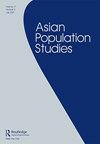Fertility differentials in Bangladesh and Pakistan: evidence from demographic and health surveys
IF 1.5
4区 社会学
Q2 DEMOGRAPHY
引用次数: 3
Abstract
ABSTRACT Following the launch of family planning programs in the 1960s and 1970s, there has been a divergence in fertility transition across Muslim countries. Bangladesh and Pakistan provide an interesting contrast in the pace of fertility transition. Typical of the Muslim world, both countries had a high fertility level of around 6.6 children per woman in the middle of the twentieth century. While the fertility level in Bangladesh had declined to replacement level by 2016, Pakistan’s fertility rate remained well above that level, at 3.5 children per woman. Drawing on data from multiple waves of the Demographic and Health Surveys to run bivariate analyses and negative binomial regression, the paper examines the determinants of fertility differentials within and across the two countries. Pakistani women had more children than Bangladeshi women across all socio-economic variables. Differences in socio-economic conditions, cultural practices such as childbearing norms, and access to family planning between the two countries are plausible reasons for the fertility variations. The paper concludes with implications of fertility differentials in developing countries, and some recommendations on strategies to enhance planned parenthood in high fertility countries.孟加拉国和巴基斯坦的生育率差异:来自人口和健康调查的证据
摘要自20世纪60年代和70年代启动计划生育计划以来,穆斯林国家在生育转变方面出现了分歧。孟加拉国和巴基斯坦在生育率转变的速度上形成了有趣的对比。作为穆斯林世界的典型代表,这两个国家在20世纪中期的生育率都很高,每名妇女生育6.6个孩子。尽管到2016年,孟加拉国的生育率已降至更替水平,但巴基斯坦的生育率仍远高于这一水平,每名妇女生育3.5个孩子。该论文利用多波人口与健康调查的数据进行双变量分析和负二项回归,研究了两国国内外生育率差异的决定因素。在所有社会经济变量中,巴基斯坦妇女生育的孩子都比孟加拉国妇女多。两国社会经济条件、生育规范等文化习俗以及计划生育机会的差异是生育率差异的合理原因。该文件最后提出了发展中国家生育率差异的影响,并就高生育率国家加强计划生育的战略提出了一些建议。
本文章由计算机程序翻译,如有差异,请以英文原文为准。
求助全文
约1分钟内获得全文
求助全文
来源期刊

Asian Population Studies
DEMOGRAPHY-
CiteScore
3.30
自引率
14.30%
发文量
12
期刊介绍:
The first international population journal to focus exclusively on population issues in Asia, Asian Population Studies publishes original research on matters related to population in this large, complex and rapidly changing region, and welcomes substantive empirical analyses, theoretical works, applied research, and contributions to methodology.
 求助内容:
求助内容: 应助结果提醒方式:
应助结果提醒方式:


